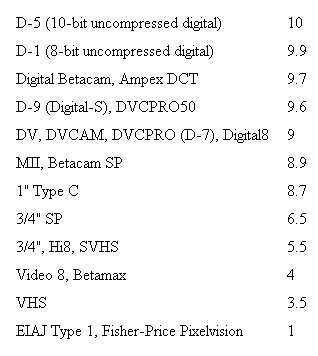There are several method for preserving video. This website makes a distinction between traditional methods and digital methods.
Digital methods are considered superior because the video is digitized using a format that is far superior to any previous analog or digital videotape format; see the ITU-BT 601 and BT 709 in the attached list of analog and digital video formats. All copies of the digital file, saved on a hard drive (HD) will be perfect; just as all digital files are perfect copies.
The tradition method of migration is to copy the historic video tape onto a new video tape. This will extend the life of historic video object, but image quality will be degraded. When an analog original (Master) is copied to make an another analog archival Submaster or a Use Copy, the succeeding generations will suffer image loss because the signal remains analog which suffers generational loss.
Creating a Use Copy, in any format, will save the original (Master) from damage caused by exhibition or archival study; see Creating Use Copies. However, such low quality reproductions cannot be considered preservation.
The following is a list of video migration possibilities:
In the following list, the current videotape formats are ranked, based on the experience of a group of video technical folks. The point is that the historic formats U-Matic, VHS, S-VHS and Betamax are ranked against their possible replacements. |
|
| The table above (from Adam Wilt's website) shows a comparison of DV (Digital Video) formats DV FAQ Technical with other common digital formats, excluding the digital format of ITU-BT 601 and -BT 709, although D-1 and D-5 are close, see the Video Format Chart in the Digital Migration section. |
The traditional method calls for a group of videotapes to be packaged and shipped to a video service bureau. In the Bay Area and Los Angles this is simple because there are many such service bureaus, but outside of major cities the process is more complex. When shipped, the owner looses control of their cultural artifacts to organizations that don't have the same respect for artifacts as Conservators or art shippers. In addition, the cost ranges from $200-400.
Because a nameless service bureau technician handles the tapes and makes critical selections such as (a) cleaning, (b) number of passes, (c) signal compression, (d) noise reduction and (e) the final appearance of the video output, the curator or archivist also looses intellectual control of the art work or historic artifact.
The format for migration is chosen based on equipment and staff availability, not on what is best for the future of the artifact.
Most service bureaus also clean every tape they migrate. The cleaning process damages the tape by scraping or dislodging magnetic material that might have remaining in place if not subjected to cleaning. Videotape clean technology was develop for used tapes that were bulk erased and returned to the used tape market. It was not developed to be gentle but to remove loose magnetic media so that it would not clog the VTR heads when reused.
|

